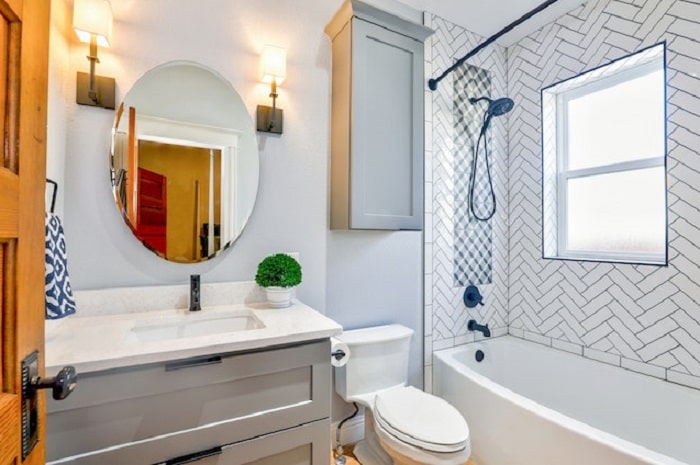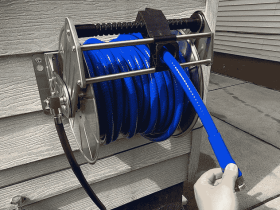Renovating a small bathroom can be an exciting project that can transform your bathroom into a stylish and functional space. However, before embarking on this project, one of the most common questions homeowners ask is, ‘how long does it take to renovate a small bathroom?’ The answer to this question can vary (23 days-46 days or about 9 weeks) depending on several factors, including the project’s scope, the design’s complexity, and contractors’ availability. But on average, we say it takes 3-9 weeks to renovate a small bathroom
One must also consider that every bathroom has different needs, and the project extent differs from one bathroom to another. This article will cover some of the factors that can affect the timeline of your bathroom renovation project.
1. Planning And Designing Phase
The planning and designing phase is the first step in any bathroom renovation project. This is the phase where you decide what changes you want to make to your bathroom, including layout, fixtures, and finishes. This phase can take a few days, depending on the complexity of the design. If you are working with a professional bathroom designer, like Kitchen & Bath, they will usually provide you with a detailed timeline for this phase.
Read more: Things to know before buying a Shower Standing Handle.
2. Demolition Phase
The next phase in a bathroom renovation is the demolition phase. The length of this phase can vary depending on the size of the bathroom and the extent of the demolition required. Fortunately, demolition isn’t complicated and might last two to four days for small to medium-sized bathrooms. However, if there are any unforeseen issues, such as water damage or structural problems, this phase may take longer than anticipated.
There may be some instances when a complete demolition is not required. In this case, the process might take two to three days since the contractors must be careful to avoid damaging areas that are not part of the renovation.
3. Rough-In Phase
After the demolition phase is complete, the rough-in phase begins. This phase involves installing or modifying the plumbing, electrical, and HVAC (heating, ventilation, and air conditioning) systems in preparation for installing new fixtures and finishes. Here are some key points to consider during the rough-in phase:
- Plumbing: During the rough-in phase, the plumbing system will be updated or modified to accommodate the new fixtures, such as the bathtub, shower, sink, and toilet. This may include relocating or adding plumbing lines, installing new valves and faucets, and ensuring proper drainage and venting. This procedure might take two days or more, depending on whether you relocate the toilet, bathtub, and other fixtures.
- Electrical: Similarly, the electrical system will be updated to accommodate any new lighting, outlets, or other electrical components. This may include installing new wiring, junction boxes, and switches, and ensuring the electrical system is up to code. Working on these electrical components in an average bathroom might take a day or two.
- HVAC: If your bathroom renovation project involves changing the layout or size of the space, the HVAC system may need to be modified as well. This may include installing new ductwork, adjusting the size or location of vents, and ensuring proper ventilation for the space. Installing ventilation needs two or three days since the contractors might need to drill a hole in your house or connect the bathroom to the existing vent.
On average, the rough-in phase typically takes around one to two weeks to complete. However, this timeline may be affected by the space layout, the materials, and the available manpower.
4. Finishing Phase
The finishing phase is a critical step in any bathroom renovation project. This is where the final details are completed to ensure the space is effective, safe, and aesthetically pleasing. Here are some key points to consider during the finishing phase:
- Installation Of Fixtures: During the finishing phase, all fixtures, such as sinks, faucets, toilets, and showerheads, are installed. The installation involves ensuring that all connections are tight and secure, and that the fixtures are properly aligned and level.
- Tiles Installation: A professional tiler can take two days to install tiles in a tiny bathroom. This is because tile cement requires drying overnight before applying grout the following day. Larger tiles are quick to install compared to smaller ones. Also, if your bathroom has a unique shape, the tiler might take longer to make cuts to fit the edges.
- Grouting And Sealing: The grouting and sealing process begins after the fixtures are installed. This involves filling in the gaps between tiles with grout and sealing them to prevent moisture from seeping through. This is important in ensuring the bathroom is watertight and will remain in good condition for years.
- Painting And Trim: Once the grouting and sealing are complete, the walls and ceilings are painted. Then the trim is added around the doors and the windows. This is where the design elements of the space really come to life, and the colors and finishes you’ve chosen will be on full display.
On average, this phase typically takes about one to two weeks to finish. Make sure that the agreed design during the planning phase was met before proceeding to the final stage, which is the final touches.
5. Final Touches
The final touches of a bathroom renovation project are the finishing details that bring the space together. These touches can include a variety of elements, such as accessories, lighting, and decorative features.
- Installation Of Accessories: Finally, the accessories such as towel bars, toilet paper holders, and shower caddies are installed. These accessories add the finishing touches to the space and ensure it’s functional and practical.
- Lighting: The right lighting can make a big difference in the look and feel of a bathroom. It’s important to choose lighting that is both functional and stylish, and that complements the other design elements of the space.
- Decorative Features: Decorative features, such as artwork, plants, and accents can also be added to give the bathroom a personal touch. These items can help to create a cohesive look and tie together the different design elements of the newly-renovated bathroom.
- Paint Touch-Ups And Cleaning: The finishing touches may also include small details such as paint touch-ups and cleaning. Ultimately, you want your space to be in pristine condition and ready for use.
The length of the final touches phase will depend on the specific elements being added. It’s important to take the time to get the details right to ensure that the final result is a space that meets your needs and exceeds your expectations.
Conclusion
I would like to provide the answer again. On average, bathroom renovations can last for 23 days or more, but the timeline depends on factors such as the bathroom size, project scope, material availability, and contractors involved. If you hire professionals to handle the project, your bathroom will be ready for use within no time since they’re experienced in handling such projects within the shortest period possible.











Leave a Review